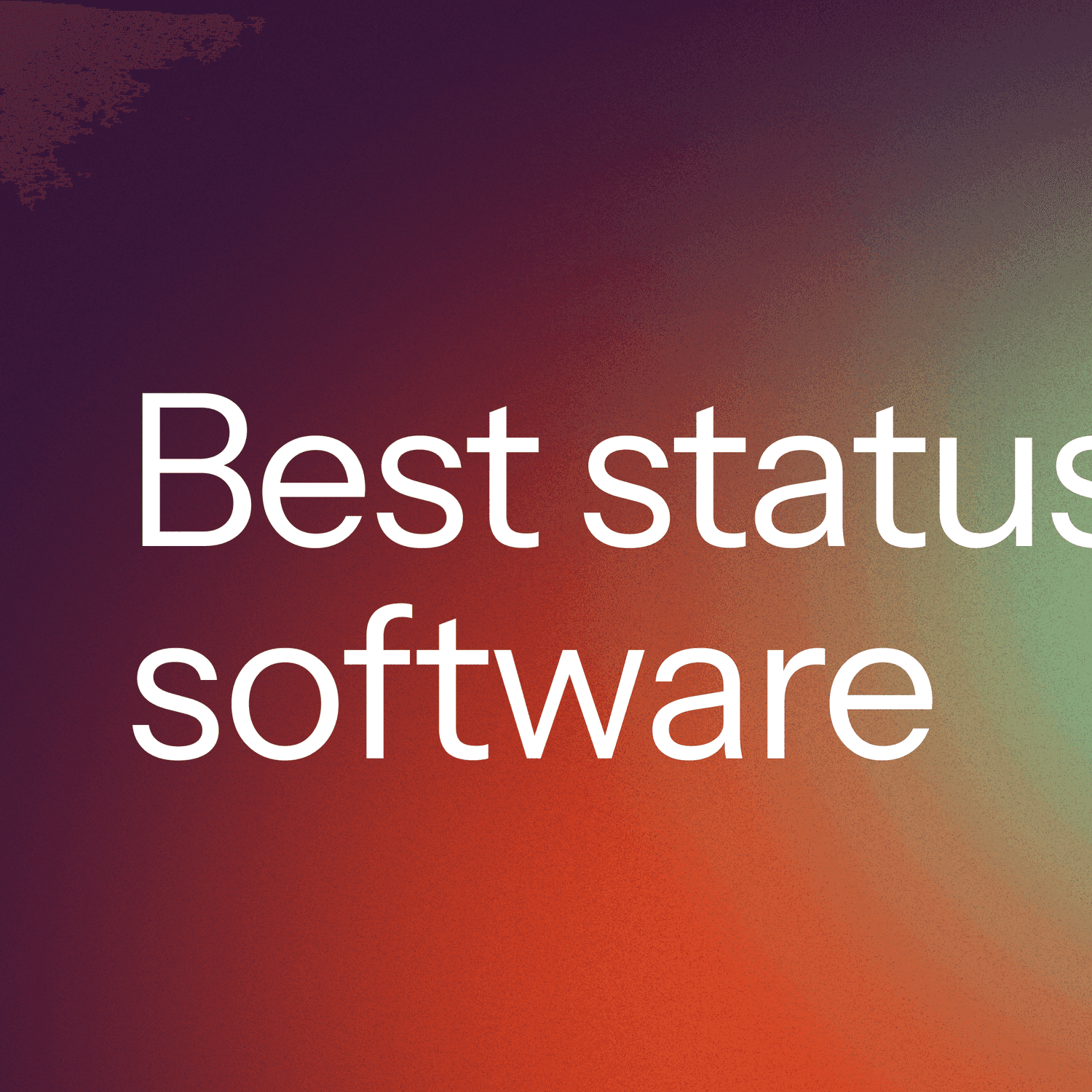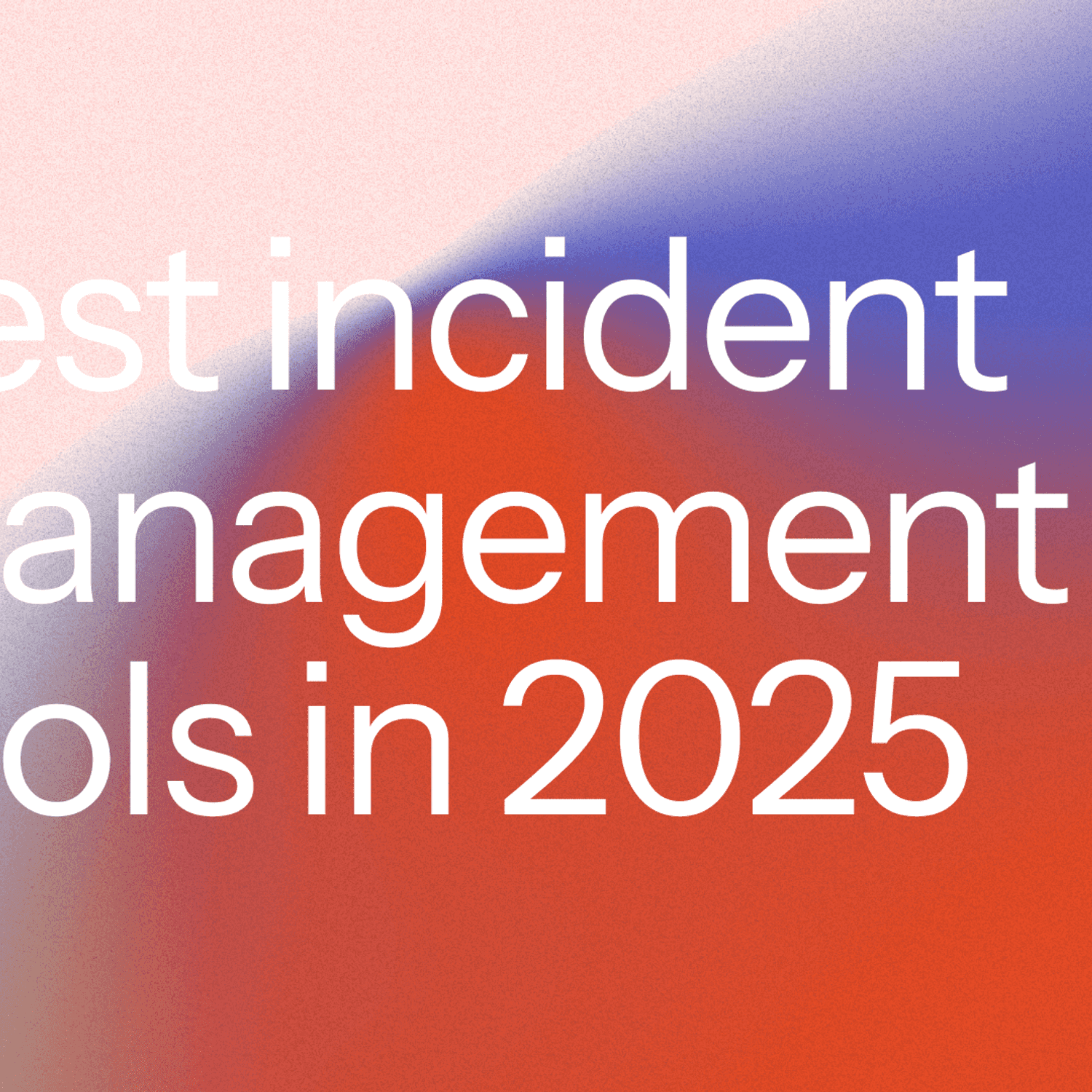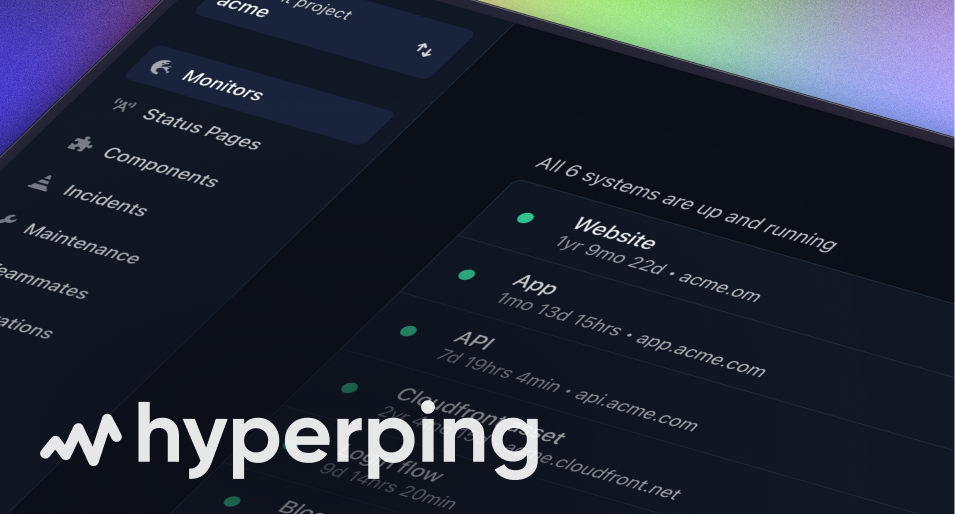Pingdom has been a pioneer in the monitoring software space. But if you're reading this, you probably know it's not the best fit anymore.
Here's the thing — the monitoring and status page landscape has evolved dramatically. New players are entering the market with innovative features, better pricing models, and improved user experiences. This has made choosing the right tool increasingly complex for DevOps and SRE teams.
In this comprehensive guide, we've analyzed 38 Pingdom alternatives to help you find the perfect monitoring solution for your needs.
We'll examine their key features, pricing structures, and ideal use cases to help you make an informed decision. Whether you're looking for better value, simpler setup, or more reliable alerting, you'll discover options that align with your team's specific requirements.
Problems with Pingdom
Pingdom made it easy for companies to track uptime and performance across their web properties.
But as technology evolves and monitoring needs grow more complex, some significant limitations have become apparent.
- False positives are a huge pain — Users frequently report getting notifications about downtime when their servers are actually online. This leads to alert fatigue and mistrust in the monitoring system.
- It's too expensive for what you get — The pricing model gets costly quickly, especially as you scale up monitoring checks. Small businesses and enterprises alike find the lack of flexible pricing plans restrictive.
- Limited locations — Pingdom has fewer monitoring locations than competitors. For companies with a global audience, this means incomplete insights into website performance across different regions.
- Support is frustratingly slow — Many users complain about delayed responses and inadequate troubleshooting assistance from the support team. Issues often go unresolved for too long.
- Advanced features are lacking — While it handles basic uptime monitoring well, Pingdom falls short on capabilities like transaction monitoring, API monitoring, and deeper customizations that modern DevOps teams need.
Pingdom isn't necessarily a bad tool — it's just that they haven't kept pace with the evolving needs of development and operations teams. The good news is there are now several alternatives that address these limitations while providing more value for your money.
Summary: Our 5 top picks for Pingdom alternatives
Hyperping Pro plan costs $74/month for 100 monitors, 10 browser checks, unlimited public & private status pages, and 6 users.
Some alternatives have complex pricing, but here's our best effort at a fair comparison.
| Total monthly price | Uptime monitors | Cron job monitors | Synthetic monitors | Advanced status pages | Users | |
|---|---|---|---|---|---|---|
| Hyperping | $74/m | 100 | ✅ | 10 | Unlimited | 6 |
| Better Stack | $199/m min. | 10 included, $21/m per 50 monitors | 10 included, $17/m per 10 monitors | $4/m for 10k runs | 1 basic included, $12/m/page + addons | $29/m/user |
| Uptime | $67/m | 50 | ✅ | 16 | 2 | 10 |
| Cronitor | $250/m min. | $2/m/monitor | $2/m/monitor | $1/m per 1k runs | 1 included, $25-50/m/page | $5/m/user |
| Uptime Robot | $29/m | 100 | ✅ | ❌ | 100 | 3 |
Open-source monitoring tool pick
In a lot of cases, open-source monitoring solutions require significant maintenance effort and setup time, making them impractical for most teams. However, if you need an open-source option, we recommend Uptime Kuma as it offers the best balance of features and ease of use in this category.
Other open-source alternatives include Nagios, Statping, Upptime, CState, and Kener, but these generally require more technical expertise to set up and maintain.
What about the other monitoring tools?
We analyzed 39 alternatives but excluded many from our detailed review for various reasons:
- Too expensive for features offered — New Relic, Dynatrace, AppDynamics, Splunk, LogicMonitor, Site24x7, Datadog
- Limited monitoring capabilities — Uptime Robot, WebGazer, Upmon, Freshping, NodePing, Pulsetic, OffAlerts
- Complex setup/enterprise focus — ThousandEyes, SolarWinds NPM, Paessler PRTG, ManageEngine
- Unclear pricing or poor documentation — StatusCast, HTTPCS, Cula.io, RapidSpike, Monitis
1. Hyperping
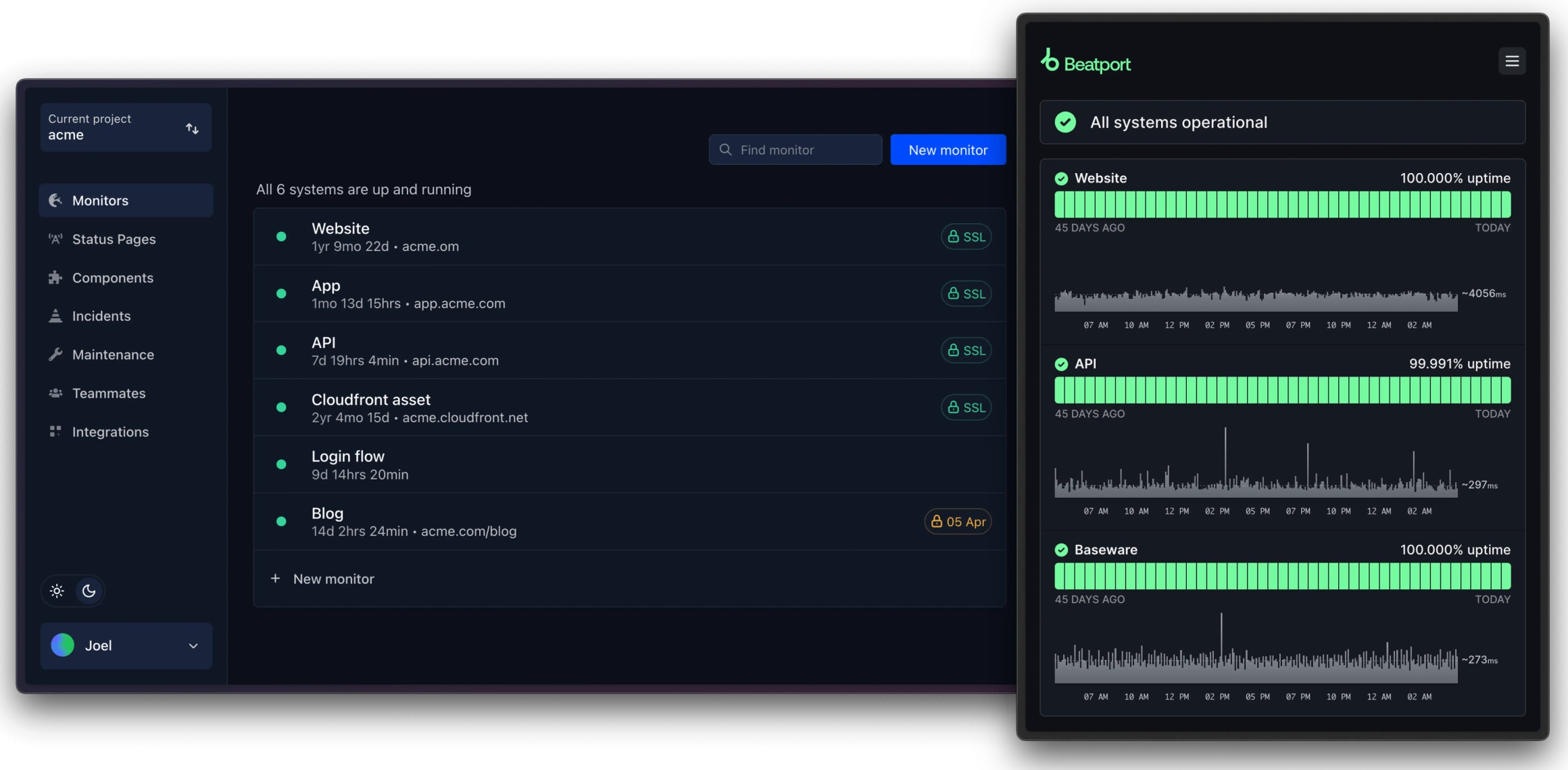
Hyperping combines comprehensive uptime monitoring with powerful status pages, designed specifically for DevOps and SRE teams in startups. Its straightforward approach focuses on what matters most: catching issues early and keeping everyone informed.
Key features
- Complete monitoring suite — URL checks, SSL monitoring, port monitoring, cron job tracking, and synthetic monitoring with Playwright.
- Fast frequency — 30-second check frequency on all paid plans with monitoring from multiple global locations.
- Advanced status pages — Public and private pages with component-level status, SSO options, and multi-tenant support.
- Response time tracking — Basic performance monitoring with response time data.
- Smart alerting — Customizable escalation policies, voice calls, and integrations with popular DevOps tools.
- EU-based infrastructure — GDPR-compliant hosting in European data centers.
Pros
- Simple, predictable pricing without per-user fees
- Quick setup with minimal configuration needed
- Code-based synthetic monitoring using Playwright
- Voice call alerts included in all plans
- Unlimited status pages on Pro & Business plans
Cons
- More basic reporting features than the competition
- Free plan a bit more limited
Bottom line
We ranked Hyperping #1 because it hits the sweet spot between functionality and simplicity. While competitors either offer too many features at premium prices or too few features at budget prices, Hyperping delivers the exact tools DevOps teams need at a fair price point.
The Pro plan at $74/month includes:
- 100 uptime monitors
- 10 synthetic monitors
- Unlimited status pages
- 5 team members (+ admin)
- All premium features
For teams that need reliable monitoring without the complexity and cost of enterprise solutions, Hyperping offers the best balance of features, usability, and value.
Compare Hyperping with other uptime monitoring tools
2. Better Stack
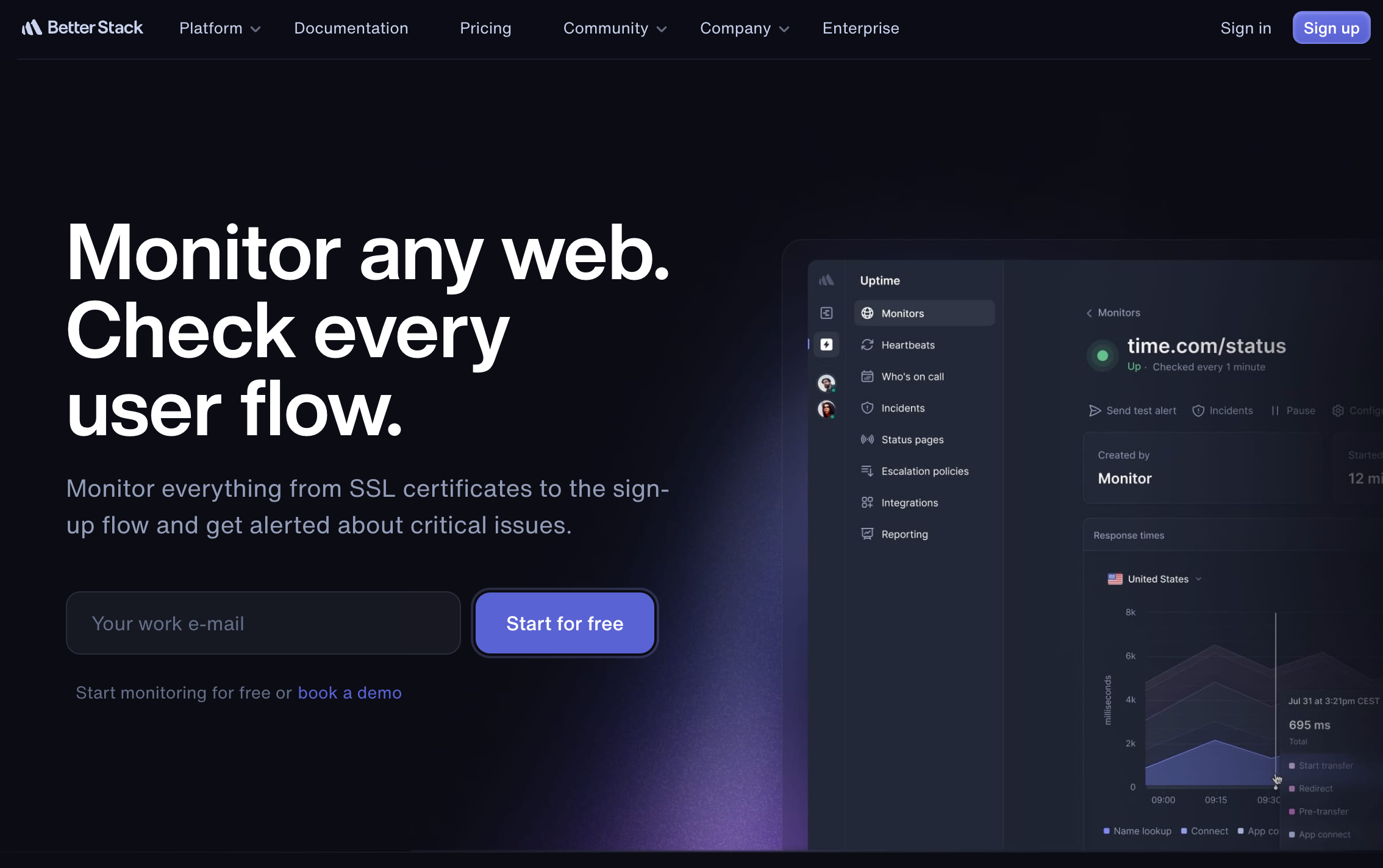
Better Stack delivers a comprehensive monitoring and incident management platform that combines uptime monitoring, logs, and on-call scheduling. It's built for engineering teams who need deep insights and robust incident response capabilities.
Key features
- Full-stack monitoring — URL checks, SSL monitoring, browser checks, and API monitoring with detailed reporting.
- Incident management — Built-in incident response tools with on-call scheduling and escalation.
- Advanced logging — Centralized log management with powerful search and analysis.
- Status pages — Customizable status pages with component dependencies and automation.
- Rich integrations — Deep integration with popular DevOps tools and services.
Pros
- Comprehensive feature set beyond just monitoring
- Powerful incident management capabilities
- Advanced reporting and analytics
- Strong API and integration options
- Modern, user-friendly interface
Cons
- Complex pricing structure with many add-ons
- Can get expensive quickly as you scale
- No longer EU-based (moved to US)
Bottom line
Better Stack ranks #2 because it offers more features than Hyperping but at a significantly higher price point. While Hyperping focuses on doing monitoring and status pages exceptionally well, Better Stack provides a broader toolkit that includes logging and incident management.
The pricing difference is substantial:
- Better Stack has a great free plan but everything more costs a lot: monitors are $21/month per 50, users are $29/month each, and status pages are $12/month each with many advanced options costing extra.
- Hyperping provides 100 monitors, 10 synthetic monitors, unlimited status pages, and 6 users for $74/month
Choose Better Stack if you need the full incident management suite and don't mind paying premium prices. Choose Hyperping if you want focused uptime monitoring and status pages at a more reasonable price point.
3. Uptime
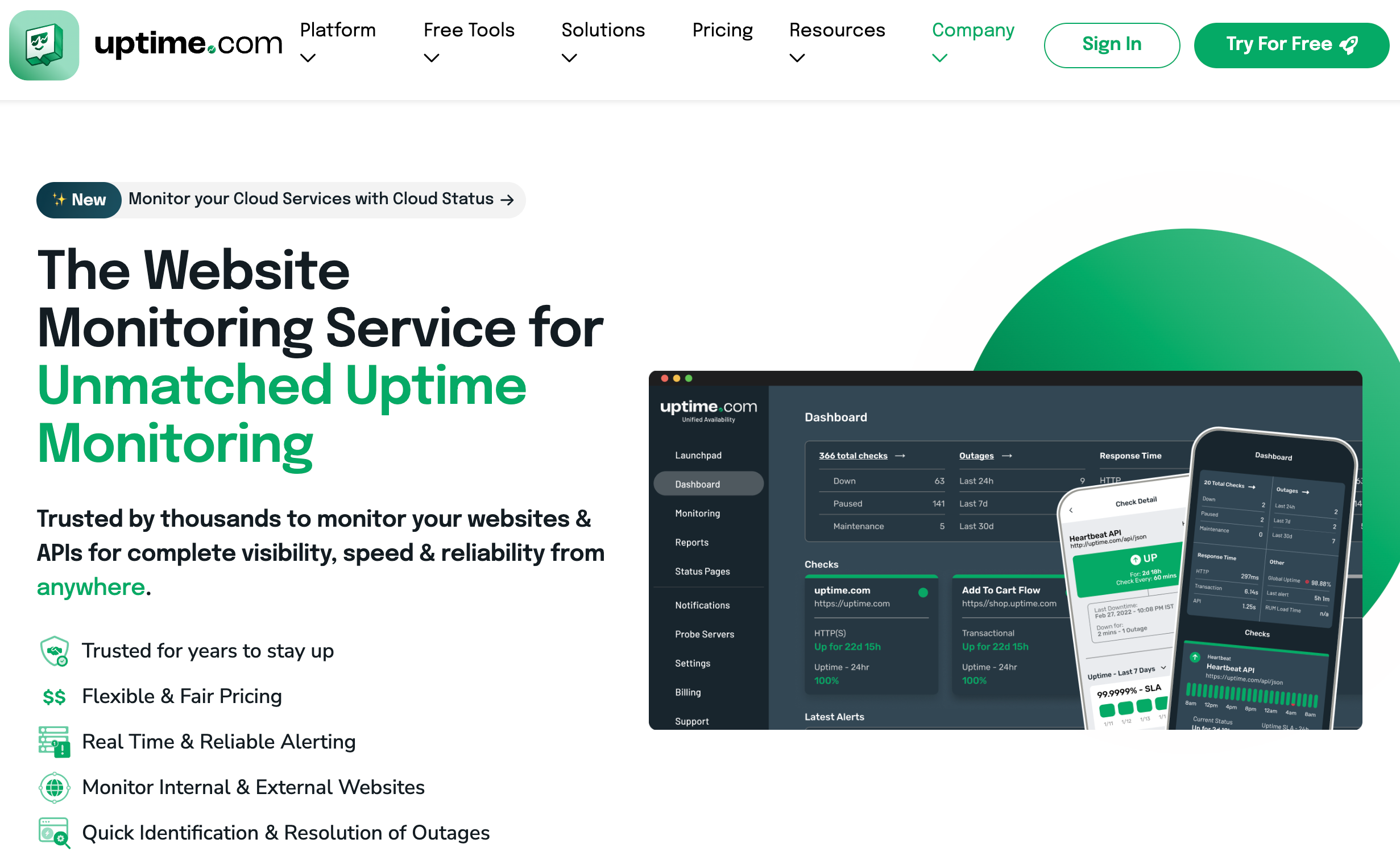
Uptime offers a comprehensive website monitoring platform with a strong focus on real user monitoring (RUM) and visual synthetic testing. Their solution caters to businesses looking for detailed performance insights alongside traditional uptime monitoring.
Key features
- Visual synthetic monitoring — No-code browser checks through a visual editor for testing user flows.
- Real User Monitoring — Track actual visitor experiences and performance metrics.
- Multi-location checks — Monitor from numerous global locations (though full access requires premium plans).
- Advanced reporting — Detailed performance analytics and custom report generation.
- Status page builder — Public status pages with branding options.
Pros
- Extensive monitoring location network
- User-friendly visual editor for synthetic tests
- Comprehensive real user monitoring
- Rich performance analytics
Cons
- Premium features locked behind expensive plans
- Escalation policies need individual setup per monitor
- Visual editor limits synthetic test capabilities
Bottom line
Uptime ranks #3 for delivering solid monitoring capabilities with valuable RUM features, but its pricing structure and limitations on basic plans hold it back from higher rankings. While Hyperping offers 30-second check frequency and unlimited status pages for $74/month, Uptime requires their $285/month plan for similar check frequencies and full location access.
For teams needing real user monitoring and visual synthetic tests, Uptime provides these capabilities well.
However, teams seeking more frequent checks, code-based synthetic monitoring, and better value should consider Hyperping's straightforward pricing and feature accessibility.
4. Cronitor
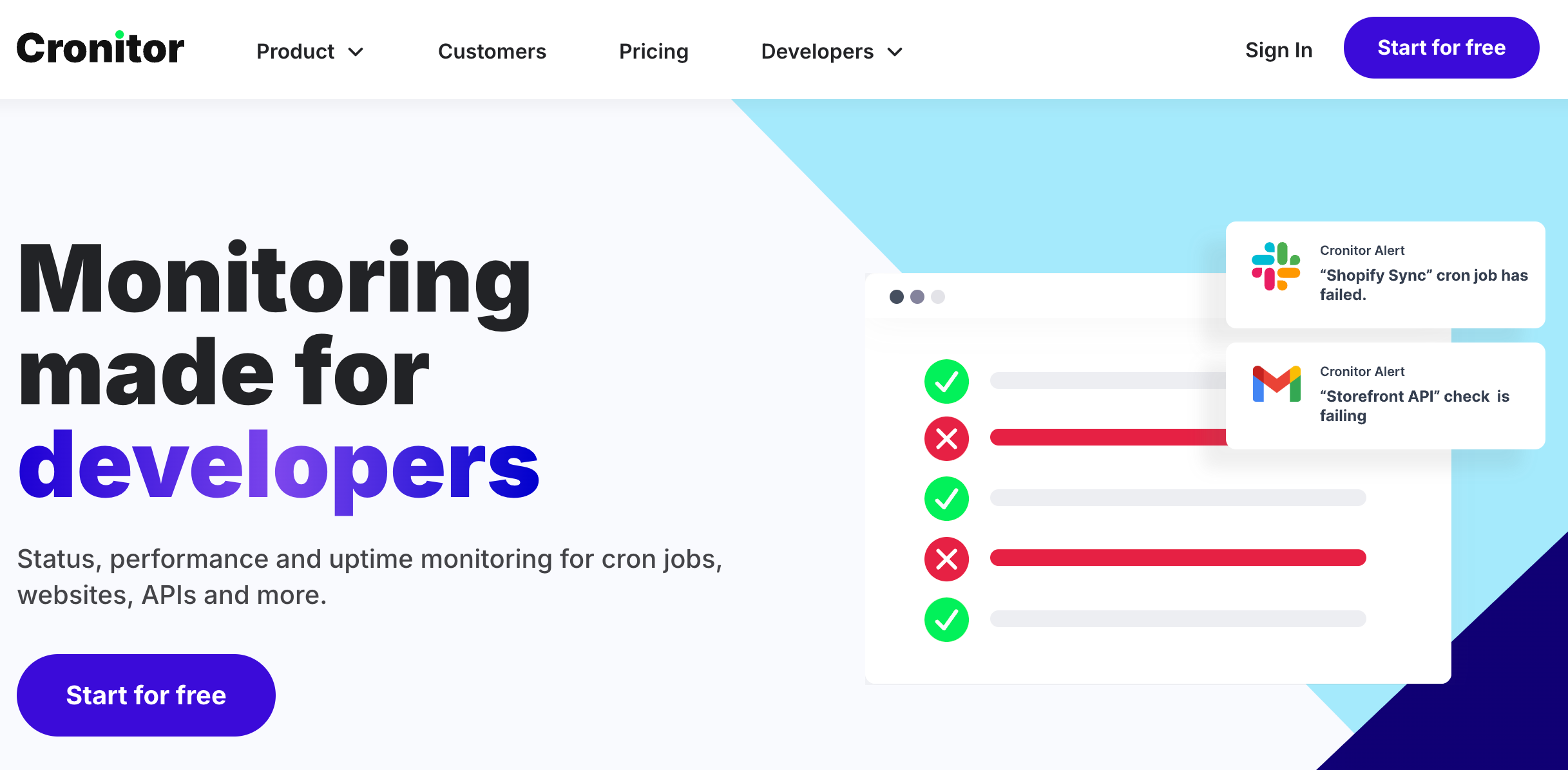
Cronitor specializes in cron job and uptime monitoring with a developer-first approach. Their platform focuses on reliability monitoring through usage-based pricing, making it particularly appealing for teams with specific monitoring needs.
Key features
- Developer-oriented monitoring — API-first platform with detailed documentation and flexible integration options.
- Comprehensive cron monitoring — Advanced scheduling options and detailed job execution tracking.
- Real User Monitoring (RUM) — Collect performance data from actual user sessions.
- Customizable reporting — Daily digests and detailed performance analytics.
Pros
- Excellent documentation and API support
- Detailed cron job monitoring capabilities
- Usage-based pricing can work well for small deployments
- Daily performance reports included
Cons
- No voice call alerts
- Limited status page functionality
- No escalation policies
- Visual editor for synthetic monitoring limits flexibility
- Usage-based pricing can become expensive quickly
Bottom line
Cronitor ranks #4 because while it excels at cron monitoring, it lacks some critical features modern DevOps teams need.
The usage-based pricing model sounds attractive but can lead to unexpectedly high costs as your monitoring needs grow.
Teams looking for predictable pricing and a complete feature set will find better value with Hyperping's straightforward plans.
5. Uptime Robot
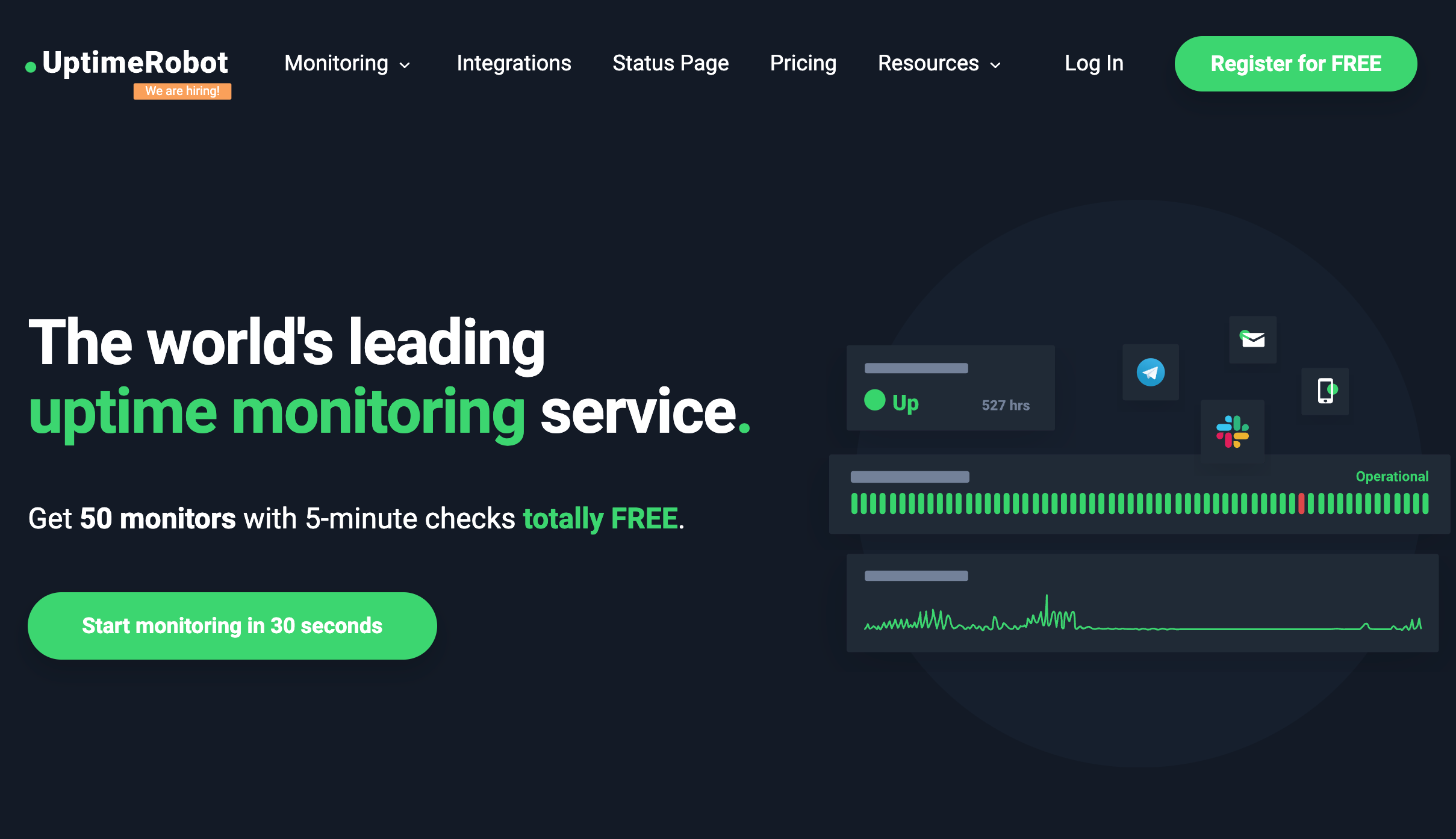
Uptime Robot offers straightforward monitoring solutions with a focus on simplicity and affordability. Popular among small businesses and developers, it provides basic monitoring capabilities with one of the most generous free plans in the market.
Key features
- Basic monitoring types — HTTP(S), ping, port, and keyword monitoring.
- Mobile apps — Native iOS and Android apps for on-the-go monitoring.
- Status pages — Basic public status pages with customization options.
- Response time tracking — Basic performance monitoring with response time graphs.
Pros
- Very competitive pricing
- Generous free plan with 50 monitors
- Simple, easy-to-use interface
- Native mobile apps
- 5-minute check intervals on free plan
Cons
- No browser checks/synthetic monitoring
- Missing escalation policies
- Limited status page features
Bottom line
We ranked Uptime Robot #5 because while it excels at basic monitoring needs, it lacks the advanced features modern DevOps teams require.
Compared to Hyperping, Uptime Robot offers a more limited toolset — particularly noticeable in its absence of synthetic monitoring and advanced status page capabilities.
While Uptime Robot costs less than Hyperping ($29/month vs $74/month), the price difference reflects significant feature gaps.
Teams needing synthetic monitoring, escalation policies, or advanced status pages should consider Hyperping's more comprehensive solution.
However, for small projects requiring only basic monitoring, Uptime Robot remains a solid, budget-friendly choice.
Common mistakes when choosing monitoring software
Choosing monitoring software isn't rocket science, but there are some common pitfalls that can lead to headaches down the road.
Let me walk you through the most frequent mistakes I see companies make, and more importantly, how to avoid them.
1. Focusing only on immediate needs
Here's the reality — your monitoring needs will evolve. What works today might not cut it tomorrow as your infrastructure grows more complex.
How to avoid it:
- Choose platforms that can scale with your growth
- Look for solutions with flexible monitoring options
- Consider tools that support emerging technologies
- Make sure the platform can adapt to changing compliance requirements
2. Overlooking total costs
Sure, the subscription price matters. But focusing solely on licensing costs often leads to expensive surprises later.
How to avoid it:
- Consider maintenance and training costs
- Factor in engineering time for integrations
- Think about the cost of running multiple tools
- Evaluate the resources needed for custom implementations
3. Neglecting integration capabilities
Your monitoring tool needs to work seamlessly with your existing stack. Otherwise, you're creating more manual work and data silos.
How to avoid it:
- Check compatibility with your current tools
- Look for webhook support and API access
- Verify integration with notification systems
- Consider using a unified solution like Hyperping that combines monitoring and status pages
4. Ignoring user experience
A powerful tool is useless if your team hates using it. Poor usability leads to low adoption and missed alerts.
How to avoid it:
- Test the interface before committing
- Ensure dashboards are intuitive
- Check if customization is straightforward
- Verify that alert management is user-friendly
5. Relying on too many tools
Using different tools for logs, metrics, and traces might seem flexible, but it often creates a mess of disconnected data.
How to avoid it:
- Look for platforms with comprehensive monitoring
- Ensure data can be correlated across features
- Choose tools that offer unified dashboards
- Consider the overhead of managing multiple vendors
6. Disregarding data accuracy
Monitoring is only as good as its data. Inaccurate or incomplete monitoring can give you a false sense of security.
How to avoid it:
- Verify data collection methods
- Check monitoring frequency options
- Ensure proper alert thresholds
- Test the reliability of monitoring locations
How to choose the right monitoring software
With dozens of monitoring tools available, each claiming to be the perfect solution, how do you choose the right one for your DevOps team?
The reality is that the "best" monitoring software depends entirely on your specific needs and constraints. What works perfectly for a large enterprise could be overkill for a startup. And what's ideal for monitoring complex microservices might be too heavy for a simple web application.
In this section, I'll walk you through exactly what you need to consider when choosing monitoring software, helping you make an informed decision that aligns with your team's requirements.
Essential features to consider
When evaluating monitoring solutions, certain features can make or break their effectiveness. Here are the key capabilities to look for:
- Real-time monitoring — Track your systems' health with minimal delay
- Comprehensive alerting — Get notified through multiple channels when issues arise
- Historical data analysis — Review past performance to identify trends
- Custom dashboards — Create views that match your team's needs
- Integration options — Connect with your existing tools and workflows
- Advanced reporting — Generate insights that help prevent future issues
- Scalability controls — Adjust monitoring scope as your infrastructure grows
- Security features — Protect sensitive monitoring data and access
Technical requirements
Don't overlook these technical aspects that ensure reliable monitoring:
- Coverage scope — Support for all your infrastructure components (cloud, on-prem, hybrid)
- Monitoring intervals — Frequency of checks that matches your needs
- Data retention — How long historical data is stored and accessible
- API flexibility — Ability to automate and extend monitoring capabilities
- Performance impact — Resource usage of monitoring agents and collectors
Business considerations
Your business context plays a crucial role in choosing the right solution. Consider these factors:
- Implementation costs — Including setup, training, and maintenance
- Pricing model — Subscription vs. licensing fees
- Team expertise — Required technical knowledge for operation
- Support quality — Available resources and vendor responsiveness
- Compliance needs — Regulatory requirements for your industry
- Growth plans — How the tool will scale with your business
Try Hyperping for free
The best Pingdom alternatives combine synthetic monitoring, cron job tracking, and automated status pages to help teams catch issues early and maintain strong SLAs.
Take these steps to find the right replacement:
- 1 — List your monitors (SSL checks, port monitoring, cron tracking, etc)
- 2 — Start a free trial of 2-3 tools that match your requirements
- 3 — Set up basic monitoring for quick wins (most tools have free versions for basic features, including Hyperping)
- 4 — Test alerting systems and status pages with your team
A solid monitoring solution helps you deliver the reliability your users need while keeping your team informed and efficient.
Hyperping combines powerful monitoring with user-friendly status pages — start your free trial now and see the difference proper monitoring makes.
Which monitoring challenge will you tackle first?


